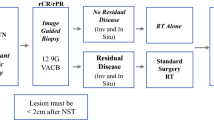Summary
While it has been demonstrated that prophylactic mastectomy reduces breast cancer incidence among women at high risk, many women often consider this disfiguring surgery unacceptable. One alternative approach may be breast reduction surgery. In order to evaluate the long-term incidence of breast cancer following surgical removal of breast tissue, we have extended by 9 years the follow-up period of our earlier retrospective cohort study of Swedish women electing cosmetic breast reduction surgery (n=30,444) between 1965 and 1993, yielding an average of nearly 16 years of follow-up. Cancer incidence through 2002 was ascertained via the Swedish Cancer Registry. Standardized incidence ratios (SIRs) and 95% confidence intervals (CIs) were calculated comparing women who underwent breast reduction surgery with women in the general Swedish population. Breast cancer was observed in 443 women versus 624 expected for a statistically significant reduced SIR of 0.71 (95% CI=0.65–0.78). Analyses by age at surgery, time since surgery or calendar year of surgery revealed similar reductions in risk. Our study of over 30,000 women with long-term follow-up offers further evidence that women undergoing breast reduction surgery have reduced breast cancer risk. As the evidence from large-scale cohort studies accumulates, direct testing of this reduction in risk through clinical trials should be considered.
Similar content being viewed by others
References
Meijers-Heijboer H, van Geel B, van Putten WLJ, et al. Breast cancer after prophylactic bilateral mastectomy in women with a BRCA1 or BRCA2 mutationN Engl J Med345: 159–164, 2001
Hartmann LC, Schaid DJ, Woods JE, et al. Efficacy of bilateral prophylactic mastectomy in women with a family history of breast cancerN Engl J Med 340: 77, 1999
Hartmann LC, Sellers TA, Schaid DJ, et al. Efficacy of bilateral prophylactic mastectomy in BRCA1 and BRCA2 gene mutation carriersJ Natl Cancer Inst93: 1633–1637, 2001
McDonnell SK, Schaid DJ, Myers JL, et al. Efficacy of contralateral prophylactic mastectomy in women with a personal and family history of breast cancerJ Clin Oncol19: 3938–3943, 2001
van Roosmalen MS, Verhoef LCG, Stalmeier PFM, Hoogerbrugge N, van Daal WAJ Decision analysis of prophylactic surgery or screening for BRCA1 mutation carriers: a more prominent role for oophorectomyJ Clin Oncol20: 2092–2100, 2002
Roukos DH, Agnanti NJ, Paraskevaidis E, Kappas AM Approaching the dilemma between prophylactic bilateral mastectomy or oophorectomy for breast and ovarian cancer prevention in carriers of BRCA1 or BRCA2 mutationsAnn Surg Oncol9: 941–943, 2002
Frost MH, Schaid DJ, Sellers TA, et al. Long-term satisfaction and psychological and social function following bilateral prophylactic mastectomyJAMA 284: 319–324, 2000
Eisen A, Weber BL Prophylactic mastectomy: the price of fearN Engl J Med340: 137–138, 1999
Swanson GP Re: risk reduction mastectomy: clinical issues and research needs (Letter)J Natl Cancer Inst94: 143–144, 2002
Stefanek M, Hartmann L, Nelson W Re: risk reduction mastectomy: clinical issues and research needs (Reply)J Natl Cancer Inst94: 143–144, 2002
Tarone RE, Lipworth L, Young VL, McLaughlin JK Breast reduction surgery and breast cancer risk: does reduction mammoplasty have a role in primary prevention strategies for women at high risk of breast cancer?Plast Reconstr Surg2004;113:2104–2110
Wells SA, Jr., Young VL, Andriole DA Atlas of Breast Surgery. St. Louis, Mo.: Mosby, 1994. 295–320
Chadbourne EB, Zhang S, Gordon MJ, et al. Clinical outcomes in reduction mammaplasty: a systematic review and meta-analysis of published studiesMayo Clin Proc76: 503–510, 2001
Lund K, Ewertz M, Schou G Breast cancer incidence subsequent to surgical reduction of the female breastScand J Plast Reconstr Hand Surg21: 209, 1987
Baasch M, Nielsen SF, Engholm G, Lund K Breast cancer incidence subsequent to surgical reduction of the female breastBr J Cancer 73: 961–963, 1996
Brinton L, Malone KE, Coates RJ, et al. Breast enlargement and reduction: results from a breast cancer case-control studyPlast Reconstr Surg97: 269–275, 1996
Boice JD, Friis S, McLaughlin JK, et al. Cancer following breast reduction surgery in DenmarkCancer Causes Control8: 253–258, 1997
Brown MH, Weinberg M, Chong N, Levine R, Holowaty E A cohort study of breast cancer risk in breast reduction patientsPlast Reconstr Surg103: 1674–1681, 1999
Boice JD, Persson I, Brinton L, et al. Breast cancer following breast reduction surgery in SwedenPlast Reconstr Surg106: 755–762, 2000
Brinton LA, Persson I, Boice JD, McLaughlin JK, Fraumeni JF, Jr. Breast cancer risk in relation to amount of tissue removed during breast reduction operations in SwedenCancer 91: 478–483, 2001
Swedish National Board of Health and Welfare. The Swedish hospital discharge register. Epidemiology Center. (Web-site assessed April 6, 2005, at http://www.sos.se/epc/english/ParEng.htm)
Bailar JC III, Ederer F Significance factors for the ratio of a Poisson variable to its expectationBiometrics 20: 639–643, 1964
Franceschi S Breast size, breast reduction, and cancer risk. Cancer Causes Control. 1997 8(2):125–126
Fryzek JP, Weiderpass E, Signorello LB, Hakelius L, Lipworth L, Blot WJ, McLaughlin JK, Nyren O Characteristics of women with cosmetic breast augmentation surgery compared with breast reduction surgery patients and women in the general population of SwedenAnn Plast Surg. 2000;45(4):349–356
Modesitt SC, van Nagell JR Jr. The impact of obesity on the incidence and treatment of gynecologic cancers: a reviewObstet Gynecol Surv. 2005 Oct;60(10):683–692
Acknowledgement
The study was financed by a grant from the International Epidemiology Institute, an independent biomedical research organization, which in turn received funding from Dow Corning Corporation, Midland, Michigan, USA. Dow Corning Corporation was not involved in any aspect of the study design, data collection, or interpretation.
Author information
Authors and Affiliations
Corresponding author
Rights and permissions
About this article
Cite this article
Fryzek, J.P., Ye, W., Nyrén, O. et al. A nationwide epidemiologic study of breast cancer incidence following breast reduction surgery in a large cohort of Swedish women. Breast Cancer Res Treat 97, 131–134 (2006). https://doi.org/10.1007/s10549-005-9099-2
Received:
Accepted:
Published:
Issue Date:
DOI: https://doi.org/10.1007/s10549-005-9099-2




